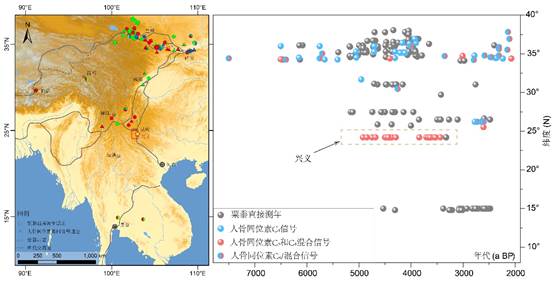professors ma minmin and dong guanghui from the environmental archaeology team of college of earth and environmental sciences, lanzhou university, together with researchers from xiamen university, yunnan institute of cultural relics and archaeology, xihu university, university college london and other research institutes, published their research results in science bulletin 2024, issue 1, titled "forager-farmer transition at the crossroads of east and southeast asia 4900 years ago". through multidisciplinary evidence, the study reveals the transition of prehistoric subsistence strategies from hunter-gatherer to agriculture in central yunnan, the hub of east and southeast asia, and pushes back the introduction of corn to yunnan to about 4900 years ago, suggesting that corn may have spread from central yunnan to southeast asia, and that the ancient population of yunnan had different biological adaptations before and after the emergence of agriculture.
the timing and path of the southward expansion of east asian agriculture and associated populations along the eastern edge of the tibetan plateau is unclear. the spread of agriculture affected changes in the lifestyles of populations, such as the transition from hunter-gatherers to agriculture, and the recipes of populations changed accordingly. therefore, changes in the food structure of populations provide an important perspective for exploring agricultural expansion and its impacts. after the emergence of agriculture, populations were subjected to significant changes in environmental stresses, and changes in physiological health may have occurred. however, direct evidence of changes in metabolism and immunity in populations before and after the onset of agriculture is scarce. isotope and paleoproteome analyses provide powerful analytical tools for exploring dietary and health changes in prehistoric populations.
central yunnan was a hub of exchange between east and southeast asia, and bones degrade readily in acidic red soil environments, so there is little direct evidence of crowd-sourced diets in southwest china. the plant, animal, and human bone remains excavated from the xingyi site in central yunnan, dating from approximately 7,000 to 3,300 years ago, provide valuable materials and opportunities to understand the transition from hunter-gathering to agriculture and changes in the physiology and health of populations in this region (fig. 1).

figure 1 photographs of excavation and sampling at the xingyi site (courtesy of yunnan institute of cultural relics and archaeology)
through extensive carbon-14 dating of human, plant and animal remains from the xingyi site, plant macro-remains, odontoblastic microsomal plant remains, multi-isotope (c/n/sr/o) and paleoproteome analyses, the research team found that the shift from wild foods to agricultural dietary patterns began as early as ca. 4,900 years before present. the discovery that the ancestors of xingyi began to consume corn about 4,900 years before present updates the earliest time of corn's spread to yunnan and provides key evidence for one of the hypothesized pathways of the spread of east asian agriculture to southeast asia (figure 2). the team also found that since the middle holocene, the subsistence strategies of the populations at the xingyi site have gone through three main phases (fig. 3), ranging from hunter-gatherer dominance (ca. 7,000-5,300 yr before present), to initial agriculture (4,900-4,300 yr before present), and then to more intensive agriculture (3,800-3,300 yr before present).

figure 2 distribution of late neolithic-bronze age corn in the eastern margin of the tibetan plateau and southeast asia (left panel) and southward spread of corn along the eastern margin of the tibetan plateau (right panel)
how did ancient people adapt to their environment during the transition from hunter-gatherer to agriculture? using pct-swath high-throughput proteomics technology to identify hundreds to thousands of classes of proteins at once, the team found that the proteomic profiles of ancient skeletons were consistent with the population classification patterns reflected in isotopically identified recipes, and that there were significant differences in metabolic and immune protein expression in ancient populations before and after the advent of agriculture, providing direct biological evidence for human adaptation during neolithization ( figure 3).

figure 3 changes in the three-stage pattern of survival strategies at the xingyi site (left panel) and significant differences in metabolic and immune proteins in the population before and after the advent of agriculture (right panel)
original message: ma minmin, lu minxia, sun rui, zhu zhonghua, fuller dorian q., guo jianxin, he guanglin, yang xiaomin, tan lingling, lu yongxiu, dong jiajia, liu ruiliang, yang jishuai, li bo, guo tiannan, li xiaorui, zhao dongyue, zhang ying, wang chuan-chao, dong guanghui. forager-farmer transition at the crossroads of east and southeast asia 4900 years ago. science bulletin, 2024, 69(1): 103-113
https://doi.org/10.1016/j.scib.2023.10.015